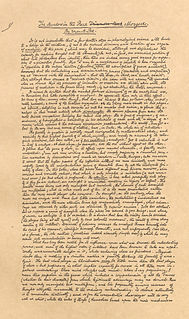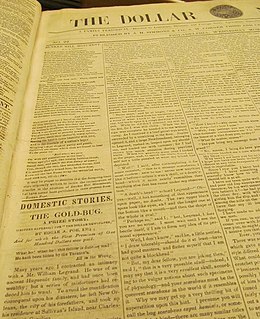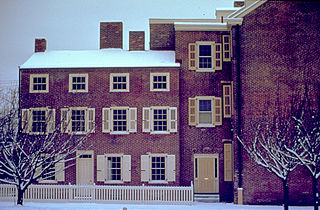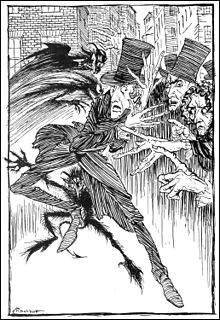
Edgar Allan Poe was an American writer, poet, editor, and literary critic. Poe is best known for his poetry and short stories, particularly his tales of mystery and the macabre. He is widely regarded as a central figure of Romanticism in the United States, and of American literature. Poe was one of the country's earliest practitioners of the short story, and considered to be the inventor of the detective fiction genre, as well as a significant contributor to the emerging genre of science fiction. Poe is the first well-known American writer to earn a living through writing alone, resulting in a financially difficult life and career.

"The Black Cat" is a short story by American writer Edgar Allan Poe. It was first published in the August 19, 1843, edition of The Saturday Evening Post. In the story, an unnamed narrator has a strong affection for pets until he perversely turns to abusing them. His favorite, a pet black cat, scratches him one night and the narrator punishes it by cutting its eye out and then hanging it from a tree. The home burns down but one remaining wall shows a burned outline of a cat hanging from a noose. He soon finds another black cat, similar to the first except for a white mark on its chest, but he soon develops a hatred for it as well. He attempts to kill the cat with an axe but his wife stops him; instead, the narrator murders his wife. He conceals the body behind a brick wall in his basement. The police soon come and, after the narrator's tapping on the wall is met with a shrieking sound, they find not only the wife's corpse but also the black cat that had been accidentally walled in with the body and alerted them with its cry.

"The Murders in the Rue Morgue" is a short story by Edgar Allan Poe published in Graham's Magazine in 1841. It has been described as the first modern detective story; Poe referred to it as one of his "tales of ratiocination".

"The Cask of Amontillado" is a short story by American writer Edgar Allan Poe, first published in the November 1846 issue of Godey's Lady's Book. The story, set in an unnamed Italian city at carnival time in an unspecified year, is about a man taking fatal revenge on a friend who, he believes, has insulted him. Like several of Poe's stories, and in keeping with the 19th-century fascination with the subject, the narrative revolves around a person being buried alive – in this case, by immurement. As in "The Black Cat" and "The Tell-Tale Heart", Poe conveys the story from the murderer's perspective.

The Edgar Allan Poe Awards, popularly called the Edgars, are presented every year by the Mystery Writers of America, based in New York City. Named after American writer Edgar Allan Poe (1809–1849), a pioneer in the genre, the awards honor the best in mystery fiction, non-fiction, television, film, and theater published or produced in the previous year.

"Annabel Lee" is the last complete poem composed by American author Edgar Allan Poe. Like many of Poe's poems, it explores the theme of the death of a beautiful woman. The narrator, who fell in love with Annabel Lee when they were young, has a love for her so strong that even angels are envious. He retains his love for her even after her death. There has been debate over who, if anyone, was the inspiration for "Annabel Lee". Though many women have been suggested, Poe's wife Virginia Eliza Clemm Poe is one of the more credible candidates. Written in 1849, it was not published until shortly after Poe's death that same year.

"The Gold-Bug" is a short story by American writer Edgar Allan Poe published in 1843. The plot follows William Legrand, who was bitten by a gold-colored bug. His servant Jupiter fears that Legrand is going insane and goes to Legrand's friend, an unnamed narrator, who agrees to visit his old friend. Legrand pulls the other two into an adventure after deciphering a secret message that will lead to a buried treasure.

Le ChevalierC. Auguste Dupin[oɡyst dypɛ̃] is a fictional character created by Edgar Allan Poe. Dupin made his first appearance in Poe's 1841 short story "The Murders in the Rue Morgue", widely considered the first detective fiction story. He reappears in "The Mystery of Marie Rogêt" (1842) and "The Purloined Letter" (1844).

"The Mystery of Marie Rogêt", often subtitled A Sequel to "The Murders in the Rue Morgue", is a short story by American writer Edgar Allan Poe written in 1842. This is the first murder mystery based on the details of a real crime. It first appeared in Snowden's Ladies' Companion in three installments, November and December 1842 and February 1843. Poe referred to it as one of his "tales of ratiocination".

The Edgar Allan Poe National Historic Site is a preserved home once rented by American author Edgar Allan Poe, located at 532 N. 7th Street, in the Spring Garden neighborhood of Philadelphia, Pennsylvania. Though Poe lived in many houses over several years in Philadelphia, it is the only one which still survives. It was designated a National Historic Landmark in 1962.

The Poe Shadow is a novel by Matthew Pearl, first published by Random House in 2006. It tells the story of one young lawyer's quest to solve the mystery of Edgar Allan Poe's death in 1849. It is a work of historical and literary fiction, where some previously unpublished details about the last days of Poe are conveyed through the thoughts and the actions of the main character, along with the generally shared ideas on Poe's death as of the publication date.

"The Unparalleled Adventure of One Hans Pfaall" (1835) is a short story by Edgar Allan Poe published in the June 1835 issue of the monthly magazine Southern Literary Messenger as "Hans Phaall -- A Tale", intended by Poe to be a hoax.

American poet and short story writer Edgar Allan Poe has had significant influence in television and film. Many are adaptations of Poe's work, others merely reference it.

"The Imp of the Perverse" is a short story by 19th-century American author and critic Edgar Allan Poe. Beginning as an essay, it discusses the narrator's self-destructive impulses, embodied as the symbolic metaphor of The Imp of the Perverse. The narrator describes this spirit as the agent that tempts a person to do things "merely because we feel we should not."

Edgar Allan Poe has appeared in popular culture as a character in books, comics, film, and other media. Besides his works, the legend of Poe himself has fascinated people for generations. His appearances in popular culture often envision him as a sort of "mad genius" or "tormented artist", exploiting his personal struggles. Many depictions of Poe interweave elements of his life with his works, in part due to Poe's frequent use of first-person narrators, suggesting an erroneous assumption that Poe and his characters are identical.

"Thou Art the Man", originally titled "Thou Art the Man!", is a short story by Edgar Allan Poe, first published in 1844. It is an early experiment in detective fiction, like "The Murders in the Rue Morgue", though it is generally considered an inferior story.

Death at the Dolphin is a detective novel by Ngaio Marsh. It is the twenty-fourth novel to feature Roderick Alleyn, and was first published in 1966 as Killer Dolphin in the United States. The plot centres on a glove once owned by Hamnet Shakespeare, on display at a newly renovated theatre called the Dolphin. Several characters from the novel return in Marsh's final book, Light Thickens.

Descendant is a 2003 film starring Katherine Heigl and Jeremy London based on the 1839 short story "The Fall of the House of Usher" by Edgar Allan Poe.

The Raven is a 2012 American crime thriller film directed by James McTeigue, produced by Marc D. Evans, Trevor Macy and Aaron Ryder and written by Ben Livingston and Hannah Shakespeare. It stars John Cusack, Alice Eve, Brendan Gleeson and Luke Evans. The title derives from Edgar Allan Poe's 1845 poem "The Raven", in the similar manner of the earlier unrelated 1935 and 1963 films.
The Pale Blue Eye is a upcoming American gothic horror crime film written and directed by Scott Cooper, adapted from Louis Bayard's 2006 novel of the same name. Christian Bale and Harry Melling lead a large ensemble cast as detective Augustus Landor and Edgar Allan Poe, respectively.

















